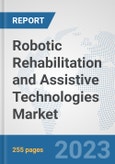Robotic rehabilitation and assistive technologies refer to the utilization of robotic devices for the rehabilitation of patients facing mobility challenges. They also have applications in therapeutic procedures that aid in the recovery of individuals dealing with various medical conditions or disabilities, including neuromotor disorders, strokes, orthopedic traumas, cognitive diseases, and spinal cord injuries. These advancements in medical robotics are transforming the healthcare sector by empowering individuals with degenerative motor and cognitive abilities to lead more independent lives.
Surgical robots assist healthcare professionals in performing complex surgical procedures with precision, while some robots enhance the accuracy of radiation therapy for cancer treatment and contribute to the rehabilitation of individuals with disabilities. The increasing prevalence of disabilities, driven by conditions such as rheumatoid arthritis, spinal cord injuries, cerebral palsy, and age-related disabilities, is expected to boost the demand for robotic rehabilitation and assistive technologies. Additionally, the growing adoption of this technology to support surgeons across various medical specialties is further propelling the growth of the robotic rehabilitation and assistive technologies market. However, a lack of awareness about this technology, particularly in emerging economies, and the high costs associated with robotic rehabilitation, pose significant barriers to market growth. Demographic shifts, technological advancements, and the need for more effective and personalized healthcare solutions present significant opportunities for the robotic rehabilitation and assistive technologies market.
From a geographical perspective, North America is projected to hold a significant share in the robotic rehabilitation and assistive technologies market, followed by Europe and the Asia Pacific regions. Factors contributing to North America's leadership include a well-established medical robotics industry and swift adoption of innovative robotic rehabilitation and assistive technologies. In Europe, the increasing incidence of disabilities is driving market growth. Furthermore, the Asia Pacific region is witnessing growth due to factors such as a rising aging population and increased awareness of this technology's benefits, which are fueling the expansion of the robotic rehabilitation and assistive technologies market.
Report Findings
1) Drivers
- The increasing prevalence of disabilities, driven by conditions such as rheumatoid arthritis, spinal cord injuries, cerebral palsy, and age-related disabilities, is expected to boost the demand for robotic rehabilitation and assistive technologies.
- The growing adoption of this technology to support surgeons across various medical specialties is further propelling the growth of the rehabilitation robotics and assistive technologies market.
2) Restraints
- A lack of awareness about this technology, particularly in emerging economies, and the high costs associated with robotic rehabilitation, pose significant barriers to market growth.
3) Opportunities
- Demographic shifts, technological advancements, and the need for more effective and personalized healthcare solutions present significant opportunities for the robotic rehabilitation and assistive technologies market.
Research Methodology
A) Primary Research
The primary research involves extensive interviews and analysis of the opinions provided by the primary respondents. The primary research starts with identifying and approaching the primary respondents.The primary respondents approached include:
1. Key Opinion Leaders2. Internal and External subject matter experts
3. Professionals and participants from the industry
The primary research respondents typically include:
1. Executives working with leading companies in the market under review2. Product/brand/marketing managers
3. CXO level executives
4. Regional/zonal/country managers
5. Vice President level executives.
B) Secondary Research
Secondary research involves extensive exploring through the secondary sources of information available in both the public domain and paid sources. Each research study is based on over 500 hours of secondary research accompanied by primary research. The information obtained through the secondary sources is validated through the crosscheck on various data sources.The secondary sources of the data typically include:
1. Company reports and publications2. Government/institutional publications
3. Trade and associations journals
4. Databases such as WTO, OECD, World Bank, and among others.
5. Websites and publications by research agencies
Segments Covered
The global robotic rehabilitation and assistive technologies market is segmented on the basis of by type, by portability, and by application.The Global Robotic Rehabilitation and Assistive Technologies Market by Type
- Rehabilitation Robot
- Assistive Robot
The Global Robotic Rehabilitation and Assistive Technologies Market by Portability
- Mobile
- Standalone
The Global Robotic Rehabilitation and Assistive Technologies Market by Application
- Stroke
- Orthopedics
- Cognitive & Motor Skills
- Sports
- Others
Company Profiles
The companies covered in the report include:
- Intuitive Surgical
- VINCENT MEDICAL HOLDINGS LIMITED
- Reha-Stim Medtec AG
- Bionik Laboratories
- Mazor Robotics (acquired by Medtronic)
- DIH Medical
- Instead Technologies, Ltd.
- Ekso Bionics
- Kinova inc.
- Others
What does this Report Deliver?
1. Comprehensive analysis of the global as well as regional markets of the robotic rehabilitation and assistive technologies market.2. Complete coverage of all the segments in the robotic rehabilitation and assistive technologies market to analyze the trends, developments in the global market and forecast of market size up to 2030.
3. Comprehensive analysis of the companies operating in the global robotic rehabilitation and assistive technologies market. The company profile includes analysis of product portfolio, revenue, SWOT analysis and latest developments of the company.
4. The Growth Matrix presents an analysis of the product segments and geographies that market players should focus to invest, consolidate, expand and/or diversify.
Table of Contents
Companies Mentioned
- Intuitive Surgical
- VINCENT MEDICAL HOLDINGS LIMITED
- Reha-Stim Medtec AG
- Bionik Laboratories
- Mazor Robotics (acquired by Medtronic)
- DIH Medical
- Instead Technologies, Ltd.
- Ekso Bionics
- Kinova inc.
- Others
Table Information
| Report Attribute | Details |
|---|---|
| No. of Pages | 255 |
| Published | October 2023 |
| Forecast Period | 2022 - 2030 |
| Estimated Market Value ( USD | $ 1.96 Million |
| Forecasted Market Value ( USD | $ 6.16 Million |
| Compound Annual Growth Rate | 13.2% |
| Regions Covered | Global |
| No. of Companies Mentioned | 10 |








